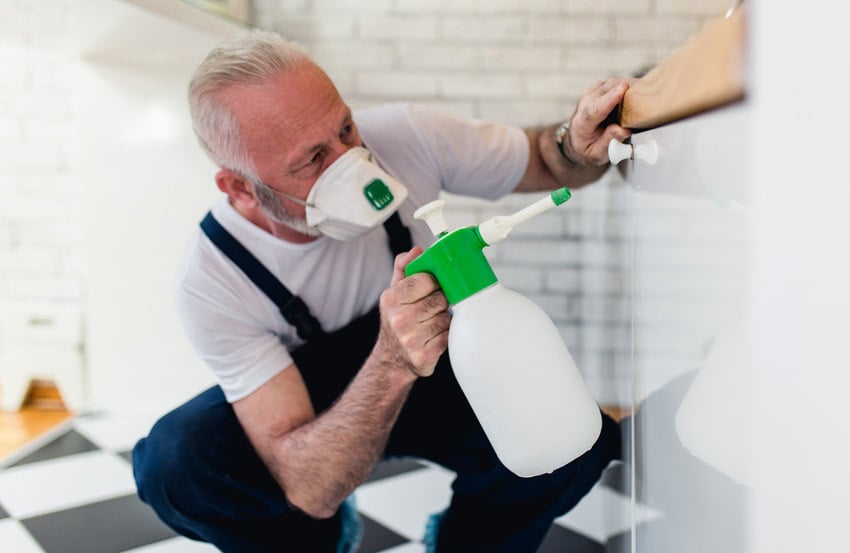Whether it's mice, rats, wasps or hornets, an infestation of pests in the home is a huge nuisance. It can be a health hazard, cause a lot of damage, and can often be difficult to get rid of.
In worst-case scenarios, rodents can chew through wires or pipes, which can cause risk of fire or leaks.
Here we look at what help your home insurance policy offers for pest control and removal.

Does home insurance cover pest control?
Most home insurance policies don’t cover pest control as standard. So if you had an infestation of mice, for example, a standard home insurance policy wouldn’t cover their removal.
But home emergency cover, which is an add-on to home insurance policies, may well cover pest infestations. For insurance purposes, anything that is bad for your health or risks damaging your home is classed as a home emergency. And policies will usually cover removal of infestations - with mice, rats, and wasps’ nests being the usual suspects.
As with all insurance, it’s important to familiarise yourself with your policy to see exactly what’s covered. Check your home emergency cover terms and conditions to see what infestations you’re covered for. You might be covered up to a certain amount for extermination, treatment, or removal.
It’s worth noting that some insurers do offer specialist standalone pest insurance, covering call-out, labour, and costs for removal or exterminating pests. If you’re considering this, check to see if it’s more expensive than getting a home insurance add-on, and compare the level of cover provided to see if it suits your needs.
What is classed as a pest and what might be covered?
The type of pests covered may vary from insurer to insurer, but policies may include:
- Black or brown rats
- Field of house mice
- Grey squirrels
- Hornet or wasps’ nests
- Cockroaches
How can home emergency cover help?
Home emergency cover aims to help you when household problems arise. These problems could damage health, make your home uninhabitable, or cause further damage. If you have this cover, a tradesperson or team of professionals will come to your home to fix the problem.
This means that, if you’re faced with an infestation, home emergency cover is likely to cover its removal. Usually, the cost of fixing the immediate problem will be covered, but not any damage caused by the problem.
So, if a wire or pipe has been gnawed through, this will be fixed. But any damage caused by water leaking from a gnawed pipe, for example, won’t be covered by your home emergency policy.
In this instance, you should look to your buildings insurance policy if any damage has been caused to your fixture or fittings as a result of pests. Or likewise, your contents insurance if there’s damage to your possessions. Again, check your policy T&Cs to see if you’re covered.
Depending on the home insurance policy you buy, home emergency cover might be included, or it may need to be bought as an add-on. For this reason, it’s best to work out exactly what you need cover for before committing to a policy.
How can I prevent pest infestations?
Pest infestations aren’t always 100% preventable. Your home may be more prone to them depending on the location, age of the property and so on. But, in general, the best tactic for stopping pests is to close entry points. Also, keep your home clean and well maintained.
Close off any gaps to your home
If you have any cracks, crevices or holes in the building, they’re a potential entry point for pests. If you can, you should seal any holes into the property, no matter how small. Mice and rats can squeeze through surprisingly tiny gaps. As such, you should seal all cracks using a caulk.
You do need some openings to your home, such as vents and air bricks to promote ventilation. If you’re worried about pests getting in, you can cover these with wire mesh so that air can still get in and out. You can also fit open drain pipes with barriers too.
Check the attic and outbuildings
If you have a loft, inspect it to make sure there are no open entrance points for pests. Similarly, keep an eye on outbuildings such as sheds. Seal any cracks or holes, and keep an eye out for wasps’ nests starting to build.
Stay on top of your kitchen hygiene
Pests are attracted to food waste. For this reason, it’s always best to clean up spills and sweep up crumbs straight away. Leftover food is best stored in sealed containers.
Manage your food bins efficiently too. Don’t leave it to overflow, and make sure your caddy is properly sealed.
If you have pets, don’t leave their food out for too long. Wash their bowls thoroughly. If your pets are pickers, you could invest in feeders which open when triggered by their microchip, for example.
Manage your household waste
Even outdoors, it’s best to make sure any bins are securely closed, and cleaned regularly. It’s better to have a compost bin than a compost heap, so that mice and rats can’t get to the food waste.
Clean your gutters
Keeping your plumbing in good working order is another way to keep unwanted visitors at bay. Leaking pipes and standing water are good breeding grounds for pests.
For this reason, it’s a good idea to clear your guttering often to keep water flowing. Also, check your pipes regularly for leaks - especially after cold snaps when they’re more likely to crack.
It’s worth knowing that if you suspect you have a leak but can’t find it, your home insurance policy is likely to have trace and access cover included. This means leaks can be identified and fixed.
Vacuum regularly
A good vacuum cleaner can help to get rid of tiny pests which may cause an infestation, such as fleas or bedbugs. If you have fleas in the house, empty the vacuum regularly into an outside bin, and wipe it down after you’ve done so.
Check your pets for fleas
Pets can bring fleas into the house, especially if they’re outdoors regularly, and come into contact with other animals. Be sure to give them their flea treatments regularly.
Also keep an eye out for excessive scratching. They might also get red lumps, pimples or blotches on their skin, or have patches of hair loss.
How can I get rid of pests?
If you do have pests or an infestation in the home, don’t panic. This is a common occurrence, and it’s usually possible to remove them without too much impact.
Take action yourself
For some pests, you may be able to deal with the problem yourself. Taking the steps outlined above - especially finding and sealing entry points - should help to tackle the problem.In the case of mice, there are plenty of humane traps readily available online or from hardware stores. Although it’s worth noting that it’s rare that you’ll have ‘a mouse’ in the house - there’s usually more than one. Rats pose more of a health concern, so it may be worth calling in the professionals.
Also, never try to deal with a wasps’ or hornets’ nest yourself.
Claim on your home emergency cover
If you have home emergency cover or a pest control add-on, this can be useful for numerous infestations - especially ones you can’t deal with yourself. Definitely call if the infestation is causing damage, a health risk or any part of your home to be uninhabitable.Bear in mind that some creatures such as ants, flies and slugs aren’t considered to be pests, so are unlikely to be covered under this kind of policy.
Call in other professionals
If you don’t have the right kind of insurance policy, it may be time to call in other professionals. You can look into private firms and exterminators in your area.
Otherwise, you can report a pest problem to your local council if you live in England or Wales. Some will treat rats, mice, bedbugs or wasps for free.







